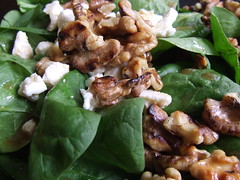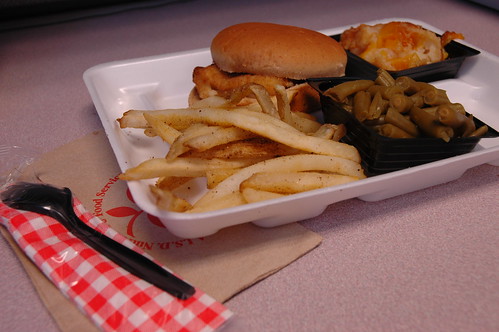I've been trying to eat healthier. This doesn't mean I've given up bacon or bratwurst. I'm only human, after all. And not an idiot. But it does mean I might forgo the second bratwurst in favor of a salad serving and might limit myself to two slices of bacon rather than four (or six....or...eight). But imagine my surprise when I began looking at salad dressings' ingredients lists: of eight dressings or marinades currently in my refrigerator, only one is free of high fructose corn syrup. And on the remaining dressings, HFC doesn't fall way down on the ingredients list. It falls no lower than fifth, and on two dressings, the balsamic vinaigrette and the honey mustard dressing, it is second, coming only after distilled water.
But none of us has to stand for this. Salad dressings aren't some alchemical secret sequestered in the ivory towers of Newman's factories. For the most part they're simple, easy to prepare and benefit from fresh ingredients (and an absence of HFC).
Blue Cheese
- 12 oz. plain yogurt (fat free is fine)
- 3 + 1 oz. crumbled blue cheese
- Juice from half a large lemon
- 1/2 tsp Worcestershire sauce
- A dash of salt
- Several to many grinds of fresh black pepper (to taste)
Combine the yogurt, 3 oz. of blue cheese, lemon juice, Worcestershire sauce and salt and pepper in a blender, food processor or other high-speed mixing environment and blend until mostly smooth.
Remove, and mix in the remaining 1 oz. crumbled blue cheese, for texture and taste.
Honey mustard dressing
- 1/3 cup olive oil
- 1 teaspoon prepared mustard (brown, whole-grain, or yellow, depending on your personal preferences)
- 1 tablespoon honey (it helps if it's warmed slightly)
- Juice from 1 large lemon
- Salt and pepper to taste
Combine all ingredients except the salt, pepper, and olive oil in a bowl. Slowly pour in the olive oil, whisking vigorously. Once the olive oil is combined with the other ingredients, season the dressing to your liking with salt and pepper. (Science content: In this recipe, the mustard acts an emulsifier, binding together the water molecules in the honey, lemon juice and the mustard itself with the fat molecules in the olive oil. It may separate some in the fridge, but you'll just have to give it a quick shake to combine again)
Orange/balsamic vinaigrette
- 1/2 Cup Orange Juice
- The juice of 1/2 large lemon (you can use the other half from the blue cheese recipe. See how I did that?)
- 2 tablespoons balsamic vinegar
- 1 tablespoon honey
Combine all ingredients in a tightly-lidded container and shake vigorously to combine. You can alter the ratio of ingredients to taste--less orange juice and more lemon juice will provide for a brighter flavor. You could also substitute other ingredients for the lemon juice. Pureed raspberries, for example would provide a wonderful depth and sweetness and might make this the perfect dressing for a fresh spinach salad with feta and roasted walnuts.
 Begin by heating a couple handfuls of shelled walnuts in a shallow pan over medium heat (one handful for each serving. Assume medium-sized hands). When they just begin to caramelize--the walnuts, I mean. If your hands are caramelizing, there's something horribly wrong--and your kitchen is filled with a wonderfully rich, nutty smell, transfer most of the walnuts to a waiting bed of fresh spinach leaves. Sprinkle liberally with feta cheese and top with the remaining walnuts. Drizzle with the orange dressing and serve immediately.
Begin by heating a couple handfuls of shelled walnuts in a shallow pan over medium heat (one handful for each serving. Assume medium-sized hands). When they just begin to caramelize--the walnuts, I mean. If your hands are caramelizing, there's something horribly wrong--and your kitchen is filled with a wonderfully rich, nutty smell, transfer most of the walnuts to a waiting bed of fresh spinach leaves. Sprinkle liberally with feta cheese and top with the remaining walnuts. Drizzle with the orange dressing and serve immediately.
This salad is a study in contrasts, with the bright, sweet dressing coupling nicely with the warm, rich flavor of the walnuts. It also provides a juxtaposition of warm and cold; crunchy, crispy and smooth; and bright acidity with rich savoriness.
What to pair it with?
Salads are usually going to call for a lighter wine, most often a white varietal. For the walnut salad, I would recommend going with a heavier Riesling, like the Blackstone 2005 vintage. This crisp, clean-tasting wine will complement the dish well, providing nice counterpoint to the walnuts heavy, smoky flavor. The wine is a little hotter than you might be used to--12.5% alcohol content--but that bit of heat provides it with a nice backbone to stand up to slightly heavier dishes than you might normally associate with a Riesling.










